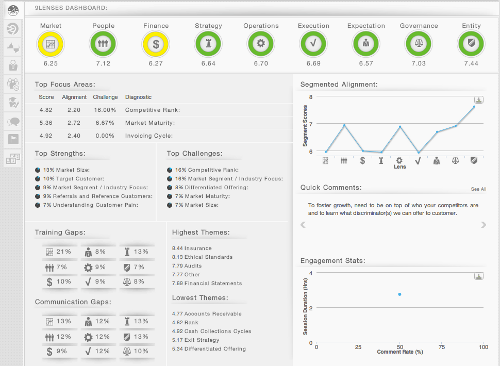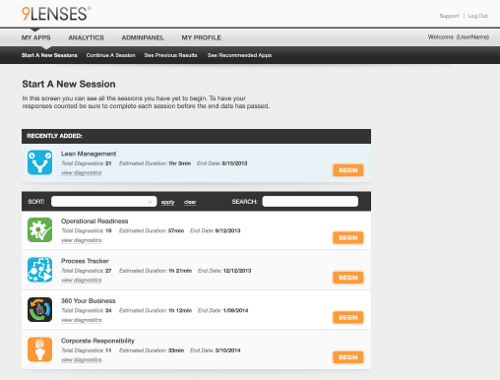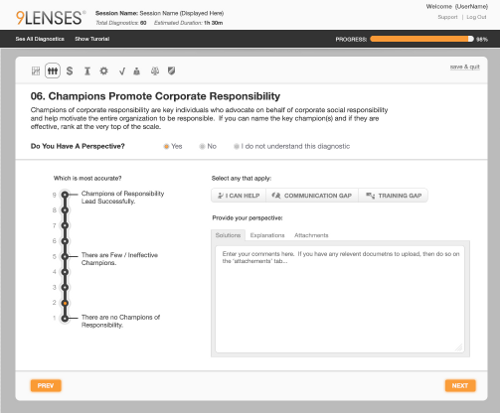The Information Age has accelerated the speed of business. Old management models are crippling effective leadership. Leaders need more data. Social discovery helps bridge the information gap. Social discovery is a helpful tool that effectively means the end of burgeoning bureaucracy and the beginning of agile, resourceful business.
Since the advent of the Information Age, speed, agility, and innovation have become critical success factors for almost every business. While the larger population of leaders today have 1980s business training and practices—like long face-to-face meetings—the mathematics of information flow and a single person’s brain being needed for most decisions simply do not add up. Ultimately, the Information Age means more people can share their pieces of knowledge and wisdom (aka “grey matter”) in ways that ideas can collide almost on their own, without a single human conductor processing and assimilating all ideas.
The great news? If you have two or more people on staff, your business is already ready to move at the speed and with the agility needed in the Information Age. It’s all about activating and connecting the grey matter. The challenge? Information Age leadership shatters 1980s leadership models of the superstar leading the minions.
The realities of mass information and big data have rapidly exposed the central weaknesses in rigid management structures, where “leadership” and “management” are too often conflated as the same thing. The consequences of hierarchy are well documented:
- Innovation Stifled. Innovation is a not a finite process or tangible resource like a standard business process. It requires creative thinking and proper stimulation. However, bureaucracy is no respecter of either. As most employees of any large businesses will tell you, the people with the most detailed exposure to key business problems often do not have the adequate authority to act on ideas for improving products or services. Thus, they have to pass the idea up the authority structure – if they ever get around to discussing the idea in the first place. Unfortunately, the most disruptive ideas can easily stall or simply disappear in the organizational structure. Unless stakeholders are particularly motivated, the vertical flow of ideas is typically extremely slow.
- Inefficiency Normalized. Researchers have long been aware of how business hierarchy tends to inhibit corporate knowledge diffusion. Some have even noted that the rigid organization structures encourage centralization of important information (Datta and Chaudhuri). For leaders in rigid organization structures, the loss of key information, rework, and sub-optimal communication are often norms. When patterns of authority are pre-set inefficiency becomes, in some form or another, an accepted part of standard business procedure.
- Ownership Decreased. While designating specific roles as sole decision makers helps maintain clarity, it also means the lower one is in the command structure, the less incentive they have to act on innovative ideas or correctional procedures. While the “frontline” employees often have the most practical understanding of how offerings and operations function, they have little perspective on the benefits of their knowledge and have little motivation to share these insights. This becomes particularly true in risk-adverse environments wherein the social costs of disruptive ideas often discourage any deviation from the norm.
Intermediate Solutions
To compensate for these consequences, businesses have adopted different techniques for manager-leaders to deploy that encourage innovation within their organization. Some have adopted modified management structures (Armour and Teece); others have built performance incentives into their compensation plan to increase personal ownership of problems among employees (Dynes and Pierce). However, any hierarchical management structure ultimately has to deal with poor information flow.
Additionally, some artistic superstar leaders have figured out how to enable a listening and responsive environment. Such leaders, however, either struggle to explain their technique or to find explanatory language not immediately discounted by those who earned their MBAs twenty years ago.
It’s Still a Stop-Gap
Leaders within a business can only accomplish so much. Even fantastic leaders will not be able to access the knowledge potential of every employee. Information leakage is the inevitable result of relying on only a select few positions for decision-making. Leaders make decisions. Thus, leaders need data. It follows that the more people with data, the more who can lead; or, rather, the more leadership may be diffused, enabling more minds to decide from exponentially improving information in an upwards cycle.
Which therefore begs a simple question: does Information Age technology enable data to flow to those who can use it?
We have a hack that provides a resounding “yes”. The key is turning “ownership” of data from the few to the many, which means jettison of the middleman collecting and filtering the data, whether through managing by walking around or six week steno-pad interviews or board room speculations.
While social discovery is simple to execute, the implications are diverse.
- Knowledge dissemination across silos. Gathering data across functional roles and positions directly disrupts the business silos within a business. Typical department silos are compared to each other to measure their understanding of the broad business context in terms of where individuals are misaligned within the business. This misalignment can drive corrective measures around specific issues.
- Leveling perspectives. Collecting perspectives from different levels of authority in the business means that the perspectives of rank and file employees are compared side by side with those of the top executives. Thus, social discovery indirectly provides validation for perspectives that might otherwise be entire lost on decision makers.
- Comparative investigation of perspectives. Social discovery is ideally situated to realign perspectives because it is directly collecting information around divergent thinking within the organization. As a consensus perspective emerges, businesses can verify the validity of individual perspectives perspectives. Without the social discovery data, such investigations would be quite difficult, if they occurred at all.
This type of data collection affords businesses with three distinct opportunities to empower employees.
- Leveraging data. Leaders can leverage the data to identify key problem solvers without depending on the rigid communication structure to collect the information. They can go directly to the source and even engage them on developing the solution. This boosts collaboration.
- Perspective shifts. Leaders have to confront the reality of the data when it diverges from their perspectives. The valuable insight they can derive from the data can help them realign their own thinking on the issue and strategically reposition their assumptions in order to develop better values for their business.
- Empowering action. From the employee perspective, utilizing data can be immensely helpful for shaping executive perspectives. Instead of relying on situational information, the employee can simply point to the data. Opportunities to act based on data directly affords more non-traditional authority to employees who would otherwise be unable to influence decision-making.
Collectively, these opportunities have great potential to disrupt the problems associated with traditional leadership structures. Social discovery serves as both a direct tool to empower employees to provide specifics solutions and an indirect method to realign traditional assumptions about innovation within the business by providing a voice for every employee.
While social discovery is simple to execute, the implications are diverse.
- Knowledge dissemination across silos. Gathering data across functional roles and positions directly disrupts the business silos within a business. Typical department silos are compared to each other to measure their understanding of the broad business context in terms of where individuals are misaligned within the business. This misalignment can drive corrective measures around specific issues.
- Leveling perspectives. Collecting perspectives from different levels of authority in the business means that the perspectives of rank and file employees are compared side by side with those of the top executives. Thus, social discovery indirectly provides validation for perspectives that might otherwise be entire lost on decision makers.
- Comparative investigation of perspectives. Social discovery is ideally situated to realign perspectives because it is directly collecting information around divergent thinking within the organization. As a consensus perspective emerges, businesses can verify the validity of individual perspectives. Without the social discovery data, such investigations would be quite difficult, if they occurred at all.
This type of data collection affords businesses with three distinct opportunities to empower employees.
- Leveraging data. Leaders can leverage the data to identify key problem solvers without depending on the rigid communication structure to collect the information. They can go directly to the source and even engage them on developing the solution. This boosts collaboration.
- Perspective shifts. Leaders have to confront the reality of the data when it diverges from their perspectives. The valuable insight they can derive from the data can help them realign their own thinking on the issue and strategically reposition their assumptions in order to develop better values for their business.
- Empowering action. From the employee perspective, utilizing data can be immensely helpful for shaping executive perspectives. Instead of relying on situational information, the employee can simply point to the data. Opportunities to act based on data directly affords more non-traditional authority to employees who would otherwise be unable to influence decision-making.
Collectively, these opportunities have great potential to disrupt the problems associated with traditional leadership structures. Social discovery serves as both a direct tool to empower employees to provide specifics solutions and an indirect method to realign traditional assumptions about innovation within the business by providing a voice for every employee.
A business, however, cannot fully leverage the disruptive potential of social discovery until they overcome several initial implementation complications. Since these are predominantly culture issues, businesses should work toward a framework of common understanding.
- Leadership buy-in. If the leadership is resistant to initially implementation, no amount of data can be leveraged to change their opinions. Often, management can be resistant to change due to the uncertainty surrounding the opportunities. Fortunately, this problem can be remedied through education and positive engagement.
- Establishing best practices for data management. Having data is helpful, however, the data itself must be useful. Unless the data is specifically tailored to specific measures, the information will end up contributing the noise created by the traditional leadership structures as opposed to disrupting the noise. The common mistake of a business newly introduced to social discovery is creating ineffective data collection mechanisms that are neither cross-relatable across the data set nor effective at eliciting the correct information from participants. The better approach would be to establish sound data collection practices around the social discovery. This would involve establishing measureable objectives around collection mechanisms.
- Implementing insights. Knowledge and execution gaps are a part of running any business. For most businesses, success requires about 20% strategy and 80% execution. It is not enough to gather data through social discovery. One must be willing to do something with it. Thus, if individuals are seeking a way to disrupt their business problems they must be willing to change. While this might seem fairly obvious, it is often the most difficult part of operationalizing the potential of social discovery.
No amount of data is a panacea for solving all business dilemmas. Unless data is repeatedly gathered around strategic areas of concern, the usefulness of social discovery will diminish. Social discovery cannot transform a business into an innovator overnight. The first step to disrupting the leadership gaps in pyramidal hierarchies is investing in social discovery tools. From there, it is a matter of dedication to continuous organizational learning.
Henry Ogden Armour and David J. Teece, “Organizational Structure and Economic Performance: A Test of the Multidivisional Hypothesis,” The Bell Journal of Economics, Vol. 9, No. 1 (Spring, 1978), 106-122.
Avimanyu Datta, and Sukumar Ray Chaudhuri, “Modeling the Effect of Rigidity in Organizational Structure on Organization Self-Renewak and Knowledge Diffusion: A Theoretical Framework,” Information Systems and Economics 2, No. 3 (2005), 1-30.
Linn Van Dyne, Jon L. Pierce, “Psychological Ownership and Feelings of Possession: Three Field Studies Predicting Employee Attitudes and Organizational Citizenship Behavior,” Journal of Organizational Behavior 25 (2004), 439-59.



I notice many echos with the hack I propose - promote silobusting, stop losing valuable ideas in hierarchical 'translation', set ideas from the floor at equal footing with those from the top etc.- maybe it's worth seeing whether my approach to collecting valuable ideas as a result of walking and talking the floor fits into your concept of gathering valuable data. My -and your- focus on alignment can help ensure that 'noise' is reduced as much as possible. Thank you for the inspiring hack.
- Log in to post comments
It is encouraging to see that there are others promoting valuable insights within a business through silobusting hierarchical inversions. In fact, I noticed a number of the hacks in this challenge actually address the issue of silobusting; yours was perhaps the most direct. To all of these ideas I say that social discovery maximizes the potential of these concepts. The brilliance of using social discovery to break silos is that it accelerates the pace of insight. It takes an individual, or even several teams entire days, weeks, or even months to walk the floor for their business. Alternatively, a social discovery platform collapses all of that procedure into a simple, easy to use discovery platform. The end result is richer data, at a faster pace. And it cost less time and money.
- Log in to post comments
Your post is highly inspirational and makes us aware of many unknown facts and truths.
- Log in to post comments
Leadership will encourage a professional to develop his or her strategy and skills. Mostly in a business sector, we have found effective leadership, which helps to guide employees, business profits, working atmosphere and many others. We can get a good amount of inspiration from different leaders to build our own strategy of working. So, we should follow professional attitude to improve our leadership quality or we should also follow https://www.certifiedcoaches.com/blog/guide-develop-leadership-quality/ for more guidance.
- Log in to post comments






You need to register in order to submit a comment.